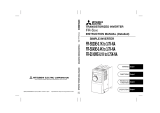
II
3.3.2 Main parameter settings...................................................................................................................................54
3.4 Operation.................................................................................................................................................................56
3.4.1 Pre-operation checks........................................................................................................................................56
3.4.2 External operation mode (Operation using external input signals)...................................................................57
3.4.3 PU operation mode (Operation using the operation panel (FR-DU04))............................................................58
3.4.4 Combined operation mode (Operation using the external input signals and PU)............................................59
4 PARAMETERS 60
4.1 Parameter List.........................................................................................................................................................60
4.1.1 Parameter list ...................................................................................................................................................60
4.1.2 List of Parameters Classified by Purposes of Use............................................................................................65
4.2 Parameter Function Details.....................................................................................................................................66
4.2.1 Torque boost (Pr. 0, Pr. 46)..............................................................................................................................66
4.2.2 Output frequency range (Pr. 1, Pr. 2) ...............................................................................................................67
4.2.3 Base frequency, base frequency voltage (Pr. 3, Pr. 19, Pr. 47) .......................................................................68
4.2.4 Multi-speed operation (Pr. 4 to Pr. 6, Pr. 24 to Pr.27) ......................................................................................69
4.2.5 Acceleration/deceleration time (Pr. 7, Pr. 8, Pr. 20, Pr. 21, Pr. 44, Pr. 45)......................................................70
4.2.6 Electronic overcurrent protection (Pr. 9)...........................................................................................................71
4.2.7 DC injection brake (Pr. 10 to Pr. 12).................................................................................................................72
4.2.8 Starting frequency (Pr. 13)................................................................................................................................73
4.2.9 Load pattern selection (Pr. 14).........................................................................................................................74
4.2.10 Jog operation (Pr. 15, Pr. 16) ..........................................................................................................................75
4.2.11 MRS input selection (Pr. 17)............................................................................................................................76
4.2.12 Stall prevention (Pr. 22, Pr. 23, Pr. 66, Pr. 148, Pr. 149, Pr. 154)...................................................................77
4.2.13 Multi-speed input compensation (Pr. 28).........................................................................................................78
4.2.14 Acceleration/deceleration pattern (Pr. 29, Pr.140 to Pr.143)...........................................................................79
4.2.15 Regenerative brake duty (Pr.30)......................................................................................................................80
4.2.16 Frequency jump (Pr. 31 to Pr. 36) ...................................................................................................................81
4.2.17 Speed display (Pr. 37, Pr. 144)........................................................................................................................82
4.2.18 Automatic torque boost (Pr. 38, Pr. 39)...........................................................................................................83
4.2.19 Up-to-frequency sensitivity (Pr. 41) .................................................................................................................83
4.2.20 Output frequency detection (Pr. 42, Pr. 43, Pr. 50) .........................................................................................84
4.2.21 Second stall prevention (Pr. 48, Pr. 49)...........................................................................................................85
4.2.22 Monitor display / FM, AM terminal function selection (Pr. 52 to Pr. 54, Pr. 158).............................................86
4.2.23 Monitoring reference (Pr. 55, Pr. 56)...............................................................................................................88
4.2.24 Automatic restart after instantaneous power failure (Pr. 57, Pr. 58, Pr. 162 to Pr. 165).................................89
4.2.25 Remote setting function selection (Pr. 59).......................................................................................................91
4.2.26 Intelligent mode selection (Pr. 60)...................................................................................................................93
4.2.27 Acceleration/deceleration reference current/lift mode starting frequency (Pr. 61 to Pr. 63)...........................94
4.2.28 Retry function (Pr. 65, Pr. 67 to Pr. 69) ...........................................................................................................95
4.2.29 Applied motor (Pr. 71)......................................................................................................................................97
4.2.30 PWM carrier frequency (Pr. 72, Pr. 240) .........................................................................................................98
4.2.31 Voltage input (Pr. 73).......................................................................................................................................99
4.2.32 Input filter time constant (Pr. 74) ...................................................................................................................100
4.2.33 Reset selection/disconnection PU detection/PU stop selection (Pr. 75) ......................................................100
4.2.34 Alarm code output selection (Pr. 76) .............................................................................................................102
4.2.35 Parameter write inhibit selection (Pr. 77).......................................................................................................103
4.2.36 Reverse rotation prevention selection (Pr. 78) ..............................................................................................104
4.2.37 Operation mode selection (Pr. 79).................................................................................................................105
4.2.38 V/F control frequency (voltage) (Pr. 100 to Pr. 109)......................................................................................108




















